
The mapping of Siberian flying squirrels has continued on an annual basis in the 2020s. The mapping continued in the spring of 2022 and 2023 aiming at finding new territories and checking the known ones. The work was designed to establish the most up-to-date information on the presence of the flying squirrel throughout the City. The sites included in the mapping consisted of woods that have been assessed in earlier mappings as suiting the Siberian flying squirrel, but where the species had not been sighted, and all known habitats of the Siberian flying squirrel that had not been checked since 2020. The inventories of flying squirrels is carried out by checking the bases of trees for droppings.
Based on the monitoring data, the Siberian flying squirrel population peaked in 2018 and 2019. Since then, some habitats have been abandoned, and the number of new habitats found has been low. The numbers of Siberian flying squirrels found in Helsinki have fallen below what they were during the peak years, but they have not decreased further in 2022 and 2023. Four new core areas and three new habitats of the Siberian flying squirrel were outlined in 2022–2023. There are a total of 156 forests and park areas in Helsinki that have been found to have been inhabited by the Siberian flying squirrel over the course of the monitoring that began in 2014. Of these areas, just over 100 have been inhabited in recent years.
Large spruces and aspens are vital to flying squirrels
In Helsinki, the majority of flying squirrel observations have been recorded in mixed forests that consist of trees of varying ages and have plenty of young broad-leaved trees growing underneath spruce-dominant stands. Large spruces and aspens are vital to flying squirrels. These trees are found in nearly all of their habitats. The squirrels usually build their nests in aspen, in old holes excavated by great spotted woodpeckers. Some flying squirrels also inhabit park areas with mature trees, mostly at the edges of wooded areas or park edges scarcely managed. Large common alders and birches are important foraging spots for flying squirrels and they like to spend time in sturdy spruces.
The habitats found during the early years of the monitoring are the ones most likely to have remained inhabited by the Siberian flying squirrel. Based on this, it would seem that as the population has grown, some Siberian flying squirrels have been forced to settle for less ideal habitats. Safeguarding the old core areas and access to them is the most important aspect of Siberian flying squirrel conservation.
“It would help safeguard the population of the Siberian flying squirrel in Uusimaa if the species were to spread through the eastern parts of Helsinki or Vantaa to Sipoonkorpi National Park, where it would find a better habitat than the most urban areas of Helsinki,” says Esa Nikunen, Head of Environmental Affairs at Helsinki Environmental Services.